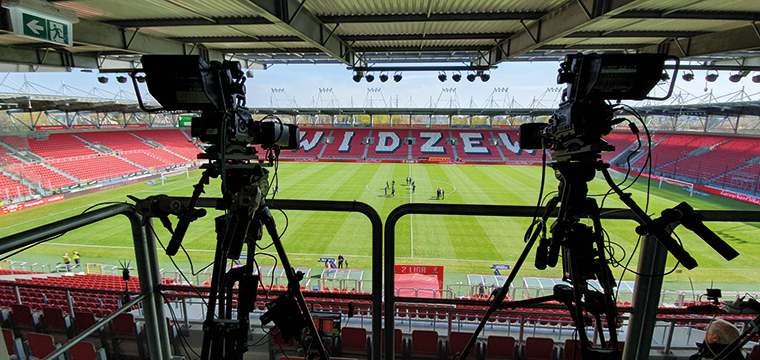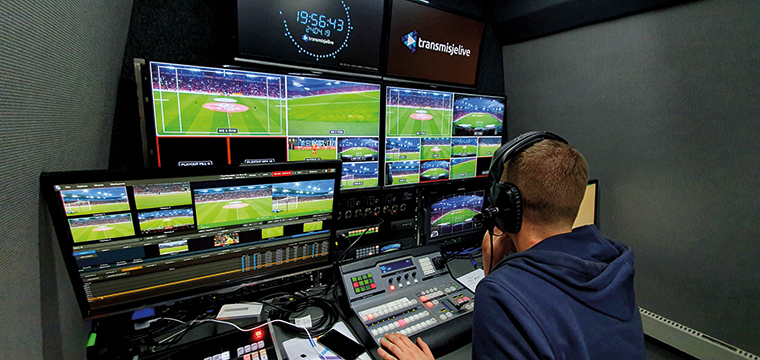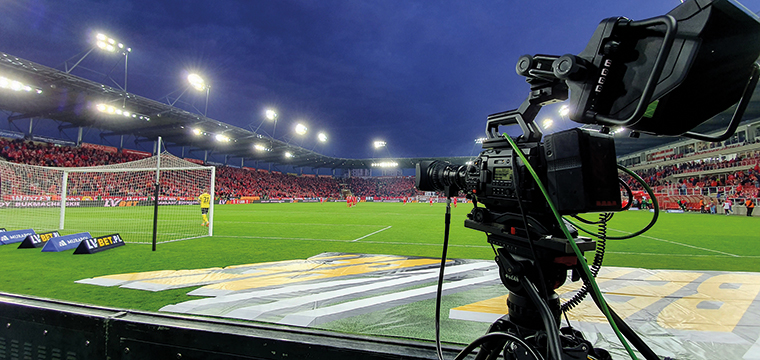Polish football enters the streaming era with Transmisjelive

Posted on Oct 21, 2019 by Alex Fice
Transmisjelive is working to bring Polish football to a mass audience with its live-streamed content
In 16 September 1937, the BBC broadcast the first live televised football match to its UK audience. The game had limited appeal – George Allison’s Arsenal were taking on Arsenal Reserves at Alexandra Palace – and only a few houses nearby could receive signal. Not much action was shown, and the programme only lasted 15 minutes – but the BBC had proved football worked on the small screen.
At the same time, in a large country at the heart of the European continent famed for pierogi and the classical nocturnes of Frédéric Chopin, television was only just being introduced. This was short-lived due to the interruption of the second world war in 1939, which brought experimentation in the new medium to end, and it wasn’t until 1952 that television finally returned to Poland, and private television stations only started appearing after the fall of communism in 1989.
Artur Kuszel, producer at Warsaw-based live production specialist Transmisjelive, tells us: “Poland has always been in a game of catch-up when it comes to broadcast innovation. While live streaming content went through a boom in the late noughties, it wasn’t until a few years ago it started to take off in Poland. Now, everyone in Poland wants to live stream their content.”
The FA For All
Kuszel talks to us specifically about Polski Związek Piłki Nożnej (PZPN), which is the governing body of association football in Poland. Transmisjelive produces all the content for PZPN’s YouTube channel Łączy nas piłka (The Ball Connects Us), including action from the men’s and women’s national teams, the second league team and the youth team.
It’s important to understand that Polish people are football-obsessed, and the country produces great footballers. Remember Zbigniew Boniek? In his active years he was scoring goals for Juventus and Roma, and he’s now the president of PZPN. But, historically, Polish football has been underserved to the global audience.

“We have a fantastic relationship with PZPN, because it’s an association of sports personalities who feel the spirit of live streaming and understand the benefits it can have on Polish football. The players want more coverage. In Poland it’s easy to catch a game of football played by the men’s national team, but they want the rest of the world to see. Conversely, the women’s national team, second league and youth teams have minimal coverage on linear television, if any,” explains Kuszel.
“The fans want to see more; they want insights into the players and coverage of conferences and events. We have the rights to broadcast this, so why not give the fans what they want? I like to think of what we do as essentially trying to show everything that linear television doesn’t,” he adds.
For the game coverage, Transmisjelive deploys an Ultra HD OB system, which is built around a Blackmagic Design workflow and includes signal management through a Smart Videohub. Ursa Broadcast camera signals are routed to an ATEM 2 M/E Production Studio 4K switcher, where the team overlays graphics and adds slow-motion replays into the programme mix using a NewTek 3Play 3P1 system.
“We choose to work with an almost complete Blackmagic Design workflow, because of its modular nature. We’re still a relatively small company; we didn’t have an investor or some guy with huge amounts of cash. When we were building our company, we could only afford to buy equipment gradually.” Kuszel adds: “I say ‘almost complete’ because Blackmagic Design does not currently do replay systems – it would be great if it did, though.”
Kuszel reveals that the set-up changes depending on the size of the event. For example, some of the youth teams’ games only have two or four crew members instead of 20, and there are two cameras instead of eight.
“We have a phrase in Polish that does not have a literal translation in English, so I will try to explain it as best as I can,” Kuszel says. “PZPN is a great client of ours, but money is also of value to us. This means the youth teams’ games are set up a little differently to others. But it all depends on how prestigious and big an event is because, sometimes, the youth teams’ games are in collaboration with UEFA Champions League, and for those we will deploy full crew and equipment.”
 Football, futbolowy: Transmisjelive employs Blackmagic Ursa Broadcast cameras to livestream the football matches
Football, futbolowy: Transmisjelive employs Blackmagic Ursa Broadcast cameras to livestream the football matches
Caught in possession
The games are live streamed to PZPN’s official YouTube channel and Facebook page, because Kuszel says these platforms are the most popular in Poland right now. On Facebook, PZPN’s page has over 1.1 million followers.
“Our president, Andrzej Duda, was the first head of state to use Facebook Live back in 2015. It was integral to his election campaign, because he used it to take questions from the comments section of the video and answer them live.” He laughs: “Sadly, we didn’t do the broadcast – although I wish we did – but it’s important to know, because Duda’s video set the precedent for many of our Polish clients.”
“Although, not all our clients want to use Facebook or YouTube,“ Kuzsel adds. “Some want their own platforms to monetise on their content, or simply because they don’t want their content to be associated with a global trademark. I often advise otherwise; Facebook and YouTube are open to the public and using these platforms is a great way to get fans and grow your brand.”

Using these social media platforms is a great way to get fans and grow your brand
Transmisjelive also uses graphics on its live streams, because Kuszel believes it helps set it apart from competitors.
“We’ve been playing around with the voting-based reactions on Facebook. For example, with Orsay, which is a clothing company in 33 different countries, we’ve been doing some small events where we’ve live streamed influencers modelling the company’s clothes. Viewers can then vote, using Facebook’s reactions, on which outfit looks best,” he clarifies.
“Graphics are important, because they’re a fun way to engage with fans. But the quality of the video has to be there first. Of course, you need a good camera and camera operator, but – while many people in the industry think ‘the picture speaks for itself’ – you also need good audio. My research, even just from my own behaviour, indicates viewers switch off a live stream if they can’t hear properly. This is a point I stress to my clients, particularly those who try to justify using a smartphone,” he adds.
Another major goal of the company is to promote PZPN’s future stars and give them experience of being interviewed on camera from a young age. Kuszel says it’s important these players, who will later go on to represent the country, know how to act appropriately in front of a camera. “When we interview the youth team’s players, we often get short ‘yes’ or ‘no’ answers,” he explains. “It’s because they’re shy, but hopefully with more experience, they will be able to play up to the camera as well as they play on the field.
“I feel proud of my job, because we’re giving young players the opportunity to be seen playing football live and on screen by their family, friends and football scouts. Youth teams from all over the world could be watching, too, and hopefully it gives them the desire to want to come to Poland and play games against our youth team.”
Lifting the silverware
Poland’s staggered start hasn’t hindered its progression, and Transmisjelive is proof the country has caught up with the live streaming boom, paving the way for the future of football broadcast not only for Poland, but the rest of world, too.

Kuszel concludes: “I’m happy with how the industry has grown in Poland, because it hasn’t just come from our desire to push live streaming and expand our business: it’s come from content creators, players and fans who believe live streaming is the future of football broadcast. I hope that, with our work with PZPN, we have improved access to all levels of football in Poland on both a national and international level.”
PS ‘Polska, biało-czerwoni’ means ‘Poland, the whites and red’ – a nod to the national colours
This article is from the August 2019 issue of FEED magazine











